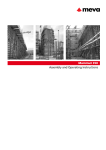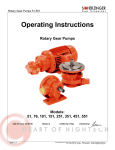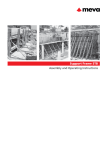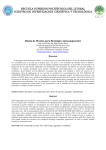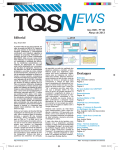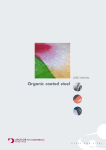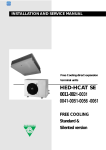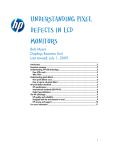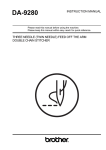Download Assembly and Operating Instructions EcoAs
Transcript
EcoAs Assembly and Operating Instructions EcoAs A versatile system for all kind of applications EcoAs is a smallsized, versatile and adaptable modular formwork system. It is most suitable for all contractors involved in structural and civil engineering projects. The economic advantages can be shown particularly in areas which are conventionally formed using traditional timber shutters, such as strip footings, foundation slabs, light shafts, various beams, landings and drain shafts. The panels can be easily assembled by hand. Through the favourable position of anchoring holes EcoAs is suited to form all kinds of foundations even with joint tapes or kickers involved. Fast panel connection The MEVA assembly lock permits the fast and safe connection of the panels. It can be attached on the frame at any position. Since the lock weighs only 1.5 kg it can be easily attached with one hand. With only a few hammer blows a safe connection and a perfect alignment are achieved. Longer life span An improved protection against rust and corrosion is ensured by a cataphoretic dip painting (well established in truck construction) carried out before the final immersion treatment. This prolongs the life span considerably and reduces the cleaning effort. Easy attachment of accessories MEVA multi-function profiles with integral Dywidag-threaded nuts facilitate the attachment of all accessory parts: · Push-pull props and alignment rails are fixed by flange screws · Scaffold brackets are quickly attached with their integrated selflocking pins · Problem areas can be overcome using Dywidag tie rods of any length which are fixed to the multifunction profile as well – independent of tensioning holes. Advantages: Few accessories, easy stock-keeping, no more searching for various parts and pieces. as of March 2003 2 Please note: This manual contains information, instructions and hints how to use the MEVA EcoAs Formwork on the construction site in a proper, quick and economic way. Generally, only asnew material may be used. Damaged parts have to be sorted out. Please apply only original MEVA spare parts for replacement. When using our products the regulations and codes of the respective country must be observed to guarantee safety. Most examples shown are standard assemblies since they occur in practice most frequently. In case of problems or special cases not dealt within this manual, please contact the MEVA experts for advise. Contents What is shown on the following pages are assembly sketches for demonstration purposes. To display details more clearly, loading and safety factor aspects are not included. The pictures show site situations which do not always depict the final assembly of the formwork with regard to safety regulations. This technical manual can be used to form part of a method statement, if required by site. The EcoAs panel ........................................................................................... 4 The alkus sheet ............................................................................................ 5 Rate of placing ............................................................................................. 6 Surface planeness ........................................................................................ 7 Connecting devices ....................................................................................... 8 Placing of ties ............................................................................................... 9 Height extension ................................................................................. 10 - 12 Substitution for ties ................................................................................... 13 90° inside corner / 90° outside corner Alu ......................................... 14 / 15 Multi-purpose panel / Corners with multi-purpose panels ............... 16 / 17 T-wall junction ............................................................................................ 18 Hinged corners ..................................................................................... 19 /20 Length compensation ................................................................................ 21 Column formwork ..................................................................................... 22 Connection to existing wall ....................................................................... 23 Stop end ..................................................................................................... 24 Wall offset ................................................................................................. 25 Projecting columns (pilasters) ................................................................... 26 Differences in height ................................................................................. 27 Panels in horizontal position ..................................................................... 28 Attachment of accessories ........................................................................ 29 Crane ganging / transport .................................................................. 30 / 31 Wall braces ................................................................................................. 32 Working scaffold ........................................................................................ 33 Assembly and stripping of the formwork ......................................... 34 - 39 Services ....................................................................................................... 40 Detailed list of EcoAs components .................................................... 41 - 60 3 EcoAs The EcoAs panel 10 Fig. 4.1 The steel frames are manufactured of closed profiles which are welded in mitred joints. These profiles are provided with a double groove and an integrated protection for the forming face. Fig. 4.1 0 23 Fig. 4.2 Pioneering panel connection with the EA-assembly lock (see page 8). Fig. 4.3 Fast and safe attachment of accessory parts at the multi-function profile (see page 29). Fig. 4.2 Fig. 4.4 The traverses, too, are made up of closed steel profiles. Fig. 4.5 Conical anchor sleeves allow an easy insertion of the tie rods (see page 9). Fig. 4.6 The transportation holes are designed to accept appropriate transporting devices. This facilitates loading/ unloading of trucks and piled-up panels can thus be moved at ground level. Fig. 4.3 Fig. 4.4 21 24 Fig. 4.5 Fig. 4.6 4 The alkus sheet Fig. 5.1 Panel profile + plywood face Negative impression in the concrete when using panels with a conventional plywood face. Fig. 5.2 Panel profil + alkus sheet Smooth and even concrete surface as there is no projecting profile of the panel frame. Plastic topping Metal or fibres Foamed plastic core Metal or fibres Fig. 5.3 Sandwich construction of an Plastic topping alkus sheet The new plastic forming face consisting of polypropylene and aluminium not only retains all the positive properties of plywood but even beats the plywood in many ways: life span, load-bearing capacity, nail-holding ability, few and easy repairs, 100 % recycling concept. An efficient production line guarantees competitive prices. Besides the obvious advantages, such as considerably reduced cleaning effort, minimum consumption of release agent and an excellent concrete finish, the ecological aspects are of importance as well. (Fig. 5.1, 5.2 and 5.3). When we substitute plastic for wood the consumption of valuable timber resources will reduced. On the other hand, further releasing of highly toxical dioxin is avoided, which is developing in the process of burning plywood (that is bonded with phenolic resin). Old and spent alkus sheets can be recycled to the same product. There is a 100 % recycling concept and a reacceptance guaran-tee given by the manufacturer. The design pattern of the alkus sheet is shown in Fig. 5.3. Fig. 5.4 5 EcoAs Rate of placing General rules for concreting based on the opposite tables (Tab. 6.1 and 6.2) • as defined in the German standard DIN 4235, concrete is placed in layers (0.5 1.00 m) • the concrete must not be placed from greater heights at free fall (max. fall height: 1.50 m) • the concrete is compacted layer by layer; attention has to be paid that the vibrator is not immersed more than 50 cm in the layer underneath • a final vibrating over the overall concrete height is not allowed, nor does it provide any advantage, for once compacted the concrete cannot be compacted any more; this may only result in water bubbles (shrinkage cavities) on the concrete surface • use a concrete with „soft“ consistence (KR /standard consistence) • no retarding agents or plasticizers are used • if special or selfcompacting concretes are used the permissible rate of placing has to be determined separately as it depends on the gross weight of the concrete. Please contact the MEVA experts for further advise. 6 Characteristic values of tie rods DW 15 Tie rod DW 15 d1 [mm] 15 d2 [mm] 17 2 Nominal cross section[mm ] 177 Permissible working load as to DIN 18216 [kN] 90 Extension of tie rods under maximum permissible working load [mm] 2.5 Tab. 6.1 1. Wall heights up to 2.40 m irrespective of the rate of placing 2. Wall heights exceeding 2.40 m 2.1 Application of tie rods DW 15 and articulated flange nut 15/120 recommended rate of placing adjusted to the permissible fresh concrete pressure according to DIN 18218. Temperature Permissible rate of placing Vb in m/h dependent air/concrete on the type of cement for standard consistence KR CEM I CEM II CEM III 15 °C 10 °C 5 °C Tab. 6.2 previously PZ 35F / PZ 45F / PZ 55F previously EPZ previously HOZ / L-NW PKZ / FAHZ / TRZ 2.00 m/h 1.40 m/h 1.00 m/h 1.60 m/h 1.05 m/h 0.75 m/h 1.20 m/h 0.70 m/h 0.50 m/h Surface planeness Tolerances of planeness for wall surfaces and floor soffits (indication of lines according to DIN 18202, table 3) The German standard DIN 18202, table 3, lines 5 to 7 („surface planeness“) defines the admissible deformation of structural parts (Tab. 7.2). The maximum rise is laid down as ultimate value dependent on the distance between the measuring points. The admissible fresh concrete pressure in compliance with DIN 18202, table 3, line 6 is of 50 kN/m² for EcoAs. line 5 line 6 tolerances line 7 spacing of measuring points Fig. 7.1 German Standard DIN 18202, table 3 Column 1 2 3 4 5 6 rise as ulitmate value in mm with a spacing of measuring points up to ...m Line Reference 5 Untreated surfaces of walls and floor soffits 6 7 Tab. 7.2 Treated surfaces of walls and floor soffits, e.g. plastered wall, wall lining, suspended ceiling 0,1 1* 4* 10* 15* 5 10 15 25 30 3 5 10 20 25 2 3 8 15 20 as in line 6, but for heigher demands * For any intermediate values see Fig. 7.1 „Tolerances of planeness“ and round up or down the values to full millimetre. The measuring rod is placed on the highest points of the surface and the deviation (rise) is measured at the lowest point in between. The distance between these highest points where the rod is placed is equivalent to the spacing of measuring points stated in the opposite table and figure respectively. 7 EcoAs Connecting devices The fast and efficient connection of the panels is effected with the EcoAs assembly lock. No matter if the panels are assembled side by side or on top of each other, the assembly lock can be attached on the frame at any position required. Owing to its 5-point contact the lock does not only draw together the panels it also aligns them (Fig. 8.1, 8.2 and 8.3). Since the lock weighs only 1.5 kg it can be easily attached with one hand, even if you are working on a ladder. See pages 11-14 for the required numbers of assembly locks. Fig. 8.1 = 5-point contact Fig. 8.2 Description Ref.-No. EA-assembly lock29-205-50 8 Fig. 8.3 Placing of ties 21 mm 24 mm Abb. 9.1 Anchor sleeve correct Fig. 9.2 Fig. 9.3 wrong Conical anchor sleeves (Fig. 9.1) for tie rods DW 15 are welded to the panel frame. The conical shape allows the formwork to be sloping – however, care has to be taken to secure the formwork against uplift by using articulated nuts. These articulated flange nuts are easily tightened and loosened with a special ratchet spanner SW 27 (Fig. 9.2). When 2 panels of a different width are assembled side by side the ties are always to be placed through the panel with the greater width (Fig. 9.3). In principle, ties have to be placed at all anchoring points. When using tie claws size 23 (Fig. 9.4), the ties can also be placed at the outside of the panels, e.g. when forming stop ends. When forming foundations a foundation tape (p. 28) allows to place the anchors beneath the formwork and a pushpull strut allows to place them above. See page 24 for further possibilities to place ties. Description Fig. 9.4 Ref.-No. Tie rod DW 15/90 ........... 29-900-80 Flange nut 100 .... 29-900-20 Articulated flange nut 120 ................ 29-900-10 Plug D 20 ............ 29-902-62 Tie claw 23 .......... 29-901-44 Ratchet spanner SW 27 ... 29-800-10 9 EcoAs Height extension 40 40 40 Combination of panels 80 40 High degree of flexibility The formwork is extended in height using panels which are assembled on top of each other in vertical or horizontal position. No matter what possibility you opt for, the connection is always made by means of the EcoAs assembly lock. The panels are available in standard heights of 240, 160 and 120 cm. By combining the panels height extensions in 40 cm steps and a uniform grid of joints are guaranteed (Fig. 10.1). Fig. 10.1 10 Make sure to attach an alignment rail of sufficient length if you extend panels in vertical position (Fig. 11.1 and 11.2). 240 400 160 Height extension 240 360 120 Fig. 11.1 Fig. 11.2 11 EcoAs Height extension Horizontal height extensions of more than 30 cm > 30 Height extension with panels in horizontal position • If the panels used for height extension have a width of more than 30 cm ties have to be placed at the anchoring points as illustrated here (Fig. 12.1). Fig. 12.1 • No ties have to be Horizontal height extensions up to 30 cm < 30 placed at the uppermost anchoring point if the panels used for height extension have a width of less than 30 cm. Exception: when using folding access platforms BKB, then again the ties have to be placed (Fig. 12.2). Fig. 12.2 12 Folding access platform 160 240 80 Substitution for ties Fig. 13.1 With a max. fresh concrete pressure of 50 kN/m2 and the surface planeness adhering to DIN standard 18202, table 3, lines 5 and 6, the following gaps can be bridged: Alignment rail AS-RS 50 AS-RS 125 AS-RS 200 Situation: 2 panels 160/80 in vertical position + height extension with 1 panel 160/80 in horizontal position (Fig. 13.1). With 2 alignment rails attached to the multifunction profiles you can bridge 2 tensioning points. Appropriate alignment rails are also used to replace the ties in the filler panel when compensating length differences (Fig. 13.2). We recommend to attach the alignment rails to the multi-function profiles and to restrict the dimension of the gap to half the length of the alignment rail used (Tab. 13.3 and 13.4). Span to be bridged up to 0,35 m up to 0,70 m up to 0,70 m Tab. 13.3 Fig. 13.2 30 30 1/4 span 1/4 length of alignment rail Fig. 13.4 Description Ref.-No. AS-alignment rail 50, galv. .............. 29-201-73 AS-alignment rail 125, galv. ............ 29-201-75 AS-alignment rail 200, galv. ............ 29-201-80 13 EcoAs 90° inside corner Fig. 14.1 10 25 23 The EcoAs inside corner consists of 2 parts. The plastic coated cover sheeting is exchangeable. Only 2 assembly locks at each side are required to connect the inside corner to the panels (Fig. 14.1). Both sides of the corner have a length of 25 cm (Fig. 14.2). Inside corner with timber or steel filler (Fig. 14.4): the connection is effected by means of 2 Uniassembly locks. In order to reinforce this area AS-alignment rails are mounted to each multi-function profile (Fig. 14.3). 10 25 Fig. 14.2 Description Ref.-No. EA-inside corner 240/25 ................. 21-725-20 EA-inside corner 160/25 ................. 21-725-25 EA-inside corner 120/25 ................. 21-725-30 Uni-assembly lock ..................... 29-400-85 Steel filler 240/5 . 21-726-00 Steel filler 120/5 . 21-726-10 14 Fig. 14.3 Fig. 14.4 90° outside corner Alu The EA-outside corner is made of plastic coated aluminium and has an integrated chamfer fillet (Fig. 15.1). The side length is of 5 cm on both sides. Together with EApanels and EAassembly locks you have a solid outside corner assembly for 90° angles with a high resistance to tensile forces (Fig. 15.2 and 15.3). Outside corners with a height of 240 cm are connected with 3 assembly locks. Only 2 assembly locks are required for outside corners 160 cm and 120 cm high. 15 10 10 15 5 5 panel 1 WS Fig. 15.1 panel width 1 = wall thickness (WS) + 20 cm Fig. 15.2 Description Fig. 15.3 Ref.-No. EA-outside corner 240 Alu ................ 21-725-85 EA-outside corner 160 Alu ................ 21-725-90 EA-outside corner 120 Alu ................ 21-725-95 15 EcoAs Multi-purpose panel The panels are particularly suited to form pilasters, stop ends, connections to existing walls, 90° corners and wall offsets (Fig. 16.1, 16.2 and 16.3). They are provided with perforated traverses where stop end fixtures (Fig. 16.3), tie rods (Fig. 16.2) and flange screws can be attached. If applied with a hinged corner there is no need for an additional alignment rail at the multipurpose panel if the distance X is less than L/2 (Fig. 16.4). If you have multipurpose panels on both sides anchors can be placed at any position required (Fig. 16.2). Note: The multi-purpose panel is named MZE in the illustrations. Multi-purpose panel Connection to existing wall Existing wall Articulated flange nut 120 Tie rod DW 15 Fig. 16.2 Pilaster Articulated flange nut 120 Fig. 16.3 Fig. 16.1 Tie rod DW 15 Flange nut 100 Stop end fixture 23/40 (yellow) Obtuse angle H <1,20 m H >1,20 m see p. 19 x l this side has to be anchored by chains to avoid a shifting of the formwork Description Ref.-No. EA-multi purpose panel 120/60 ................. 21-720-51 Stop end fixture 23/40 (yellow) ..... 29-402-85 16 Fig. 16.4 Articulated flange nut 120 Tie rod DW 15 Corners with multi-purpose panels 30 25 30 25 Fig. 17.1 Fig. 17.1 and 17.2 outline corner solutions with multipurpose panels for wall thicknesses of 25 and 30 cm. The perforated traverses of the panel are punched every 2.5 cm (Fig. 17.4). This allows an accurate forming of all the typical dimensions found in the field of stop ends, pilasters, 90° angles and wall offsets. Fig. 17.2 Attention: The stop end fixture must not be inserted into the outermost tie hole because it has to fully rest on the panel (Fig. 17.3). 37 25 25 2 5 25 37 120 Note: The multi-purpose panel is named MZE in the illustrations. Fig. 17.3 60 Fig. 17.4 17 EcoAs T-wall junction This configuration is assembled using two inside corners (Fig. 18.1 to 18.3). Different wall thicknesses are compensated for by means of either the EA-compensation plate (6-20 cm) plus EA-assembly lock (Fig. 18.4) or with timber fillers plus Uni-assembly lock 22 (0-17 cm) (Fig. 18.5). Adm. span dependent on the type of alignment rail Fig. 18.1 Standard panel Fig. 18.2 adm. from 6 to 20 cm 18 Timber filler Alignment rail (see p. 13) Fig. 18.3 0 -17 cm Compensation plate + EAassembly lock Timber filler + Uni-assembly lock 22 Fig. 18.4 Fig. 18.5 Hinged corners 25 25 >100° Additional timber spacer 55 80 80 55 Fig. 19.1 Acute and obtuse angled corners are formed using hinged inside (Fig. 19.3) and outside (Fig. 19.4) corners. Alignment rails are mounted to the multi-function profiles of the outside corner assembly to provide accurate alignment (Fig. 19.1 and 19.2). With an internal angle of more than 100°, alignment rails and timber spacers are used on the inside corner assembly as well (Fig. 19.1). Timber fillers and Uni-assembly locks 22 are used to compensate length differences. Side length of outside corners: 7.5 cm Side length of inside corners: 30 cm Adjustment range of both corners: 60° – 180°. max. 60° Fig. 19.2 Description Fig. 19.3 Fig. 19.4 Ref.-No. EA-hinged inside corner 120/30 ...... 21-726-40 EA-hinged inside corner 240/30 ...... 21-726-30 EA-hinged outside corner 120 ........... 21-726-60 EA-hinged outside corner 240 ........... 21-726-50 19 EcoAs Hinged corners It is recommended to secure the alignment rail with flange screws before installing the anchors (Fig. 20.1). The size of the timber fillers depends on the wall thickness, the internal angle and the panel width. See table 20.2 for details. Connection with flange screw 18 and flange nut 100 Hinged outside corner Timber filler + Uni-assembly lock y = panel width "E1" + appropriate timber filler Panel Hinged inside corner Internal angle α S W Fig. 20.1 WS calculation of the variable remainder y = ______________ α + 22,5 [cm] tan 2 _ Wall thickness Internal angle α in cm (WS) Tab. 20.2 20 y in cm Panel width E1 Timber filler 24 70 75 85 96 110 146 168 - 75° 85° 96° 110° 146° 168° 180° 55 50 45 40 30 25 Timber filler + plywood panel 25,0 - 22,5 1,8 - 0 5,0 - 0 5,0 - 0 5,0 - 0 10,0 - 0 5,0 - 0 25 70 73 82 94 108 145 168 - 73° 82° 94° 108° 145° 168° 180° 55 50 45 40 30 25 Timber filler + plywood panel 25,0 - 22,5 3,2 - 0 5,0 - 0 5,0 - 0 5,0 - 0 10,0 - 0 5,0 - 0 30 70 85 95 106 120 152 170 - 85° 95° 106° 120° 152° 170° 180° 55 50 45 40 30 25 Timber filler + plywood panel 25,0 - 22,5 10,3 - 0 5,0 - 0 5,0 - 0 5,0 - 0 10,0 - 0 5,0 - 0 Length compensation Timber filler The compensation of length differences of up to 17 cm can be made on site with a timber filler and Uniassembly locks 22. This section is reinforced using alignment rails (Fig. 21.1 to 21.3). Fig. 21.1 0-17cm Uni-assembly lock 22 Compensation plate The plate is used to compensate length differences of 6 to 20 cm. For the reinforcement of these areas alignment rails are mounted. 2 EAassembly locks are sufficient to connect the compensation plate to the adjacent panel (Fig. 21.4 and 21.5). ´ Fig. 21.2 Fig. 21.3 <70cm 6-20cm Fig. 21.4 Tie rod DW 15 Alignment rail EcoAs-panel Compensation plate Description Fig. 21.5 Ref.-No. Uni-assembly lock 22 ................ 29-400-85 EA-compensation plate 120/20 ........ 21-726-20 21 EcoAs max. 1.20 max. 0.90 Fig. 22.2 max. 0.60 Fig. 22.1 max. 2.40 Foundations with a section of up to 90 x 90 cm (Fig. 22.2) and a concreting height of 1.20 m (Fig. 22.1) can be easily formed using standard panels and outside corners. For heights up to 1.20 m 2 assembly locks are sufficient at each joint. Columns with a side length up to 60 cm (Fig. 22.4) and a height of 2.40 m (Fig. 22.3) are formed in the same way, however require 3 assembly locks (Fig. 22.3). Greater column sections and heights require additional walers in order to be able to take the high fresh concrete pressure. max. 0.90 Column formwork max. 0.60 Fig. 22.4 Fig. 22.3 Description Ref.-No. EA-outside corner 240 Alu ................ 21-725-85 EA-outside corner 160 Alu ................ 21-725-90 EA-outside corner 120 Alu ................ 21-725-95 22 Connection to existing wall Timber spacer (same thickness as panel) Existing tie hole Fig. 23.2 Fig. 23.1 Panels of different length Fig. 23.3 Hexagonal nut + backing plate Connection through existing tie hole using an alignment rail Various possibilities to connect the formwork to an existing concrete wall are shown in the opposite sketches (Fig. 23.1 to 23.5). According to the conditions on the construction site the most suitable solution may be chosen. Just take care that the formwork is tightly pressed to the existing wall in order to avoid a leaking of the fresh concrete and a patchy concrete finish. For connecting the formwork to existing walls or previous concreting sections with the use of multipurpose panels (Fig. 23.6 and 23.7) see page 16. Fig. 23.5 Fig. 23.4 Connection to the previous concreting section using multi-purpose panels Fig. 23.6 MZE MZE MZE MZE Fig. 23.7 23 EcoAs Stop end Stop ends can either be formed using stop end fixtures + alignment rails (Fig. 24.2), or outside corners + standard panels (Fig. 24.5 and 24.6). The former solution requires either additional ties outside the panels that are placed through tie claws 23 (Fig. 24.1, 24.2 and 24.4) or a direct anchoring through the tie hole (Fig. 24.3). The latter solution requires an additional reinforcement with alignment rails if the panel width is of more than 50 cm (Fig. 24.5). Detail tie claw 23 2 alignment rails per panel Tie rod Stop end fixture 23/40 Tie claw 23 EA-panel Reinforcing bars Fig. 24.1 Joint tape Fig. 24.2 Fig. 24.3 Anchoring through tie hole Fig. 24.4 Anchoring with tie claw 23 An additional reinforcement with alignment rail is necessary Stop end with EA-outside corners 55 50 55 50 panel width max. 50 cm Description Ref.-No. Stop end fixture 23/40 (yellow) ..... 29-402-85 Tie claw 23 .......... 29-901-44 24 Fig. 24.5 Fig. 24.6 up to the 1st anchoring point 0-10 Wall offset Detail A Tie rod DW 15 with flange nut Timber spacer One-sided wall offsets of up to 10 cm are formed by simply shifting back the corresponding panel (Fig. 25.1 and 25.3). For offsets exceeding 10 cm inside corners should be used (Fig. 25.2 and 25.4). All offset sections up to a maximum of 25 cm have to be reinforced by alignment rails (Fig. 25.1 and 25.2). 10-25 Fig. 25.1 Fig. 25.2 Detail A Detail B Connection with Uni-assembly lock 22 Detail B Description Uni-assembly lock 22 Timber spacer Fig. 25.3 Fig. 25.4 Ref.-No. EA-outside corner 120 Alu ................ 21-725-95 EA-outside corner 160 Alu ................ 21-725-90 EA-outside corner 240 Alu ................ 21-725-85 Uni-assembly lock 22 ................ 29-400-85 25 EcoAs Projecting columns (pilasters) Ordinary projections are easily formed using inside corners, standard panels, and where it is necessary some timber spacers. The static reinforcement of the projecting sections is achieved by means of alignment rails (Fig. 26.1 to 26.3). Flange screw 18 Tie rod with flange nut Timber spacer Timber spacer Fig. 26.1 Flange screw 18 Tie rod with flange nut Fig. 26.2 Flange screw 18 Tie rod with flange nut Timber spacer Wooden block Fig. 26.3 26 Differences in height Fig. 27.1 Fig. 27.3 Fig. 27.4 As the assembly lock can be fixed at any position on the panel frame, the formwork is totally independent of a connection grid and requires no additional accessories for assembly. Vertical, horizontal, height differing (Fig. 27.1 and 27.2) and even inclined panels can all be safely connected by means of EAassembly locks. Compensations and adjustments to the concrete structure are made up of timber strips, squared timber and plywood panels which are cut to the size required. Again connection is achieved with the EA-assembly locks. Alignment rails are used to transfer the fresh concrete pressure in the compensation area (Fig. 27.3 and 27.4). Fig. 27.2 the substructure is made-up on site Timber filler 27 EcoAs Panels in horizontal position Fig. 28.2 max. spacing Foundation tape Push-pull strut 80 40 Fig. 28.1 Foundation formwork Fig. 28.3 Fig. 28.4 Push-pull strut (0-60 cm) Fig. 28.5 with tie rod and push-pull strut Foundation tape Tensioning device Push-pull strut 80 40 Due to the central position of anchoring holes in the horizontally arranged 80 cm wide panels (Fig. 28.1 to 28.5), EcoAs is particularly suited to form complicated foundations even with joint tapes or kickers involved. With this formwork height of 80 cm inside corners 120 cm are used if angles are involved. Push-pull struts (0-60 cm) permit to tighten the panels above the formwork; thus you avoid placing the upper tie in the concrete. The use of foundation tapes and tensioning devices (Fig. 28.6 to 28.8) saves the lower anchors. The tensioning device is attached to the formwork with a wedge. The maximum spacing of these devices depends on the concreting height and is: e = 1.85 m for 80 cm e = 1.20 m for 100 cm e = 0.70 m for 135 cm. Fig. 28.6 Fig. 28.7 Foundation tape Tensioning device Description Ref.-No. Push-pull strut .... 29-105-70 Foundation tape .. 29-307-50 Tensioning device 29-307-75 Cart for foundation tape ... 29-307-55 28 Fig. 28.8 with foundation tape and push-pull strut Attachment of accessories Fig. 29.1 Fig. 29.2 Fig. 29.3 Fig. 29.4 Fig. 29.5 Fig. 29.6 All panels are provided with multifunction profiles (Fig. 29.1 and 29.7). These differ from the usual horizontal profiles in featuring Dywidagthreaded nuts which are welded inside. The multi-function profile permits fast attachment of accessory parts like wall braces (Fig. 29.5 and 29.6), alignment rails (Fig. 29.2), squared timber etc. by means of flange screws. Scaffolding brackets are provided with selflocking pins and thus can be mounted to the multi-function profile as well (Fig. 29.3 and 29.4). Another advantage: projections and other problem areas in concrete structures are easily overcome by means of Dywidagthreaded tie rods of any length. These ties can be efficiently fixed to any multi-function profile, independent of the anchor holes. Fig. 29.7 29 EcoAs Crane ganging The admissible load capacity of the EcoAs crane hook (Fig. 30.1) is of 300 kg. The handling: Open the safety lever as far as possible (Fig. 30.2). Then push the crane hook over the panel frame until the nose engages completely in the groove. Put the safety lever back to the starting position to lock the crane hook (Fig. 30.3). Safety test The crane hook has to be checked regularly before using it on a new construction site. When exceeding the admissible load capacity of the crane hook the material may be strained which again might result in a permanent deformation. In this case a safe application cannot be guaranteed any more. Attention: Make sure to use always 2 EA-crane hooks even on individual panels when you move them by crane (Fig. 30.4 and 30.5). Features of separation If the control measure (Fig. 30.2) exceeds 32 mm the crane hook has to be replaced immediately. This is also applicable if only one side of the hook exceeds this measure. Accident prevention The Health and Safety regulations of the country where the crane hooks come into use have to be strictly observed. When attaching a crane hook to a horizontal panel always place it above a traverse (Fig. 30.4). When moving larger panel units take care to attach the crane hook at a panel joint (Fig. 30.6) so that it cannot disengage. Fig. 30.1 32 mm control measure Fig. 30.3 Fig. 30.2 max. 60° max. 60° Fig. 30.4 max. 60° Fig. 30.5 Description Ref.-No. EA-crane hook .... 29-103-90 30 Fig. 30.6 Crane ganging / transport max. 60° Always use 2 crane hooks. Weight of gang is max. 600 kg (300 kg per crane hook) Fig. 31.1 When moving larger panel units take care to attach the crane hook at a panel joint (Fig. 31.1) so that it cannot disengage. Gang with EApanels 160/80 including accessories (ASalignment rail 125) (Fig. 31.1). Weight: 425 kg. Transport angle The transport angles (Fig. 31.2) permit a space-saving storage of panels without the need for any supporting timber. Even if the pile is not completed a 4-rope crane sling (never use a 2-rope sling) can be attached directly above the topmost panel. 5 to 12 EA-panels can be moved at a time. The maximum load-bearing capacity of a transport angle is of 10 kN. Description Fig. 31.2 Ref.-No. Transport angle 10 .............. 29-305-10 Transport angle 10, rigid type ...... 29-305-15 31 EcoAs Wall braces Push-pull porps / wall braces Wall braces are attached to the multifunction profiles of the panels by means of formwork-prop connectors (Fig. 32.1). If the wall braces are only needed to align the formwork we recommend a spacing of max. 3.75 m. In case the formwork has to be secured against wind load as well the spacing has to be reduced to 2.70 m. For further applications please contact one of our engineers. • The formwork height and the length of the push-pull prop should be the same. The angle between brace and push-pull prop should not exceed 60° (Tab. 32.2). • Make sure to tightly secure the foot plate of the wall brace to the floor slab with dowels. Horizontal spacing of push-pull props / wall braces to align the formwork ≤ 3,75 m to take wind loads ≤ 2,70 m ≤ 60° Fig. 32.1 Description Ref.-No. Range of ad- Adm. pres- Tensile Weight justment (m) sure (kN) force (kN) (kg) Recommended application Brace SRL 120 29-108-80 0.90 - 1.50 20 30 6.0 horizontal adjustment of the bottom of the form, wall brace 250, climbing formwork Brace SRL 170 29-108-90 1.20 - 2.20 25 40 10.5 Push-pull prop R 160 29-109-40 1.35 - 2.00 25 25 11.0 horizontal adjustment Push-pull prop R 250 29-109-60 1.90 - 3.20 25 30 18.5 upper prop of wall brace 250 up to a wall height of 3.75 m Push-pull prop R 460 29-109-80 3.40 - 5.20 20 30 35.8 wall formwork up to a wall height of 6.00 m Push-pull prop R 630 29-109-85 5.10-7.60 9.5 9.5 67.8 wall formwork up to a wall height of 9.00 m Braces SRL Description Ref.-No. Push-pull prop R 160 .................. 29-109-40 Push-pull prop R 250 .................. 29-109-60 Push-pull prop R 460 .................. 29-109-80 Brace SRL 120 .............. 29-108-80 Brace SRL 170 .............. 29-108-90 Brace frame 250 with Combiassembly lock .... 29-109-22 Brace frame 250 with connector ............ 29-109-20 32 folding shaft formwork Push-pull props R Tab. 32.2 Working scaffold Guard-railing post Scaffolding bracket Fig. 33.1 Side railing 29 intermediate guard-rail Minimum section of guard-rails: toe board Extract of table 8 of German DIN 4420, part 1 15 x 3 cm - with a spacing of posts up to 2.0 m 20 x 4 cm - with a spacing of posts up to 3.0 m min. 10 x 3 adm. bracket spacing (m) for platforms made up of boards / planks 135 90 24 guard-rail Scaffolding bracket Scaffolding brackets 90 are provided with self-locking pins. Thus they are suspended at the multi-function profile and fastened to the next multifunction profile located below by means of a flange screw (Fig. 33.1). Scaffold boards/ planks are mounted to the bracket to complete the working platform. Max. bracket spacing with an assumed load of 150 kg/m²: 2.50 m dependent, however, on the type of gang-boards used (see opposite table 33.3 / DIN standard 4420). Separate guardrailing posts 100 are fixed to the scaffold brackets. An additional side railing (with guard-rail, intermediate guard-rail and toe board) is required if the height above ground is of 2.0 m or more (Fig. 33.2). Scaffold Widthof Thickness of group boards/ boards / planks (cm) planks (cm) 3.0 3.5 4.0 4.5 5.0 1, 2, 3, 20 1.25 1.50 1.75 2.25 2.50 24,28 1.25 1.75 2.25 2.50 2.75 765 Fig. 33.2 <30 Tab. 33.3 Description Ref.-No. Scaffolding bracket 90 ........... 29-106-00 Scaffolding bracket 125 ......... 29-106-50 Guard-railing post 100 .............. 29-106-75 Side railing 90/100 ................. 29-108-20 Side railing 125/100 ............... 29-108-30 33 EcoAs Assembly and stripping of the formwork In the following we take a straight wall as an example to illustrate the sequence of operations. Transport: When unloading the truck and moving piles of panels on the construction site take care to use appropriate crane slings or the like (Fig. 34.1). Assembly: Erect the first panel and immediately attach a push-pull prop. Anchor the prop to the ground in order to prevent the panel from tilting over. Erect further panels and connect them to each other with EAassembly locks (see page 8). Spray the forming face with the release agent MevaTrenn FT8. Attach the working scaffold (Fig. 34.2) and mount a side railing. Fig. 34.1 Fig. 34.2 34 Assembly and stripping of the formwork After installing the reinforcement the opposite side can be assembled to close the formwork. Ties are placed for preventing the panels on the opposite side from tilting over as well (Fig. 35.1). Finally, complete the working scaffold and mount side railings (Fig. 35.2). Fig. 35.1 Pouring: When pouring the concrete adhere to the admissible rate of placing. Compact the concrete using vibrators (while observing the German standard DIN 4235, part 2); see page 6 for furter instructions. Fig. 35.2 35 EcoAs Assembly and stripping of the formwork Stripping: After the initial setting of the concrete the formwork can be stripped. Start removing the panels that were erected last (opposite side) (Fig. 36.1). Now clean the panels and apply a new layer of release agent before the next use. If you have EcoAs panels with alkus plastic sheets we recommend to use the special release agent MevaTrenn FT 8 and to apply it every 3rd time. Fig. 36.1 Fig. 36.2 36 Assembly and stripping of the formwork The panels can be removed by using a crane hook either one by one or as larger panel units after the wall braces and the respective assembly locks have been removed (Fig. 37.1 and 37.2). Relevant information: The accident prevention regulations of the country where the formwork system comes into use have to be strictly observed. Fig. 37.1 Fig. 37.2 37 EcoAs Assembly / stripping of the formwork Planning stage: Reasonable planning and work preparation guarantee most successful application of modern formwork systems. First of all, the necessary quantity of formwork material has to be determined. In this regard several factors of influence should be taken into account: • weight of the formwork to be handled • time allowed for assembly and stripping • transport of the formwork from one pouring cycle to the next – either panel by panel, or in large-size panel units (which considerably reduces the forming time) • capacity of the lifting equipment • size of pouring cycles (taking into account the number of corners etc.) With all the aspects considered, the quantities of formwork items can be specified. In general this is done on the basis of a daily use of the formwork on a new pouring cycle. Area of support: The area where the formwork is to be erected should be clean, even and capable of bearing the expected load. 38 Assembly of the formwork: In most cases it is recommended to erect the external formwork first. Always start at a fixed end and immediately attach a push-pull prop to the panels erected (Fig. 39.2). If you choose to preassemble large-size panel units on the ground, push-pull props and working scaffold are attached at the same time before erecting the whole unit. You should have an even area available for the preassembly. Panel connection: In general the panels are connected using 2 assembly locks: Exception: with 90° corner configurations the outside corners (h = 2.40 m) are connected to the adjacent panels by means of 3 assembly locks (Fig. 38.1 and 38.2). Bracing of the formwork: After erecting the panels push-pull props have to be attached immediately in order to prevent the panels from tilting over. Therefore the foot plates of the props have to be safely anchored to the ground. If anchored to the soil, 2 ground nails are used, if anchored to a concrete base, 2 heavy-duty dowels are required. The spacing of pushpull props is described on page 32. Fig. 38.1 Clearance for easy stripping Fig. 38.2 Assembly / stripping of the formwork Working scaffold: Scaffolding brackets (Fig. 39.2) are quickly attached with their integrated selflocking pins. The brackets are the basic item for the working scaffold. The bracket spacing varies depending on the type of gang-boards used (see description on page 33 / table 8 of DIN 4420 part 1). The gang-boards can be fixed to the scaffold brackets. The gang-boards must not be placed on the scaffold brackets before 1. the push-pull props are attached to the formwork 2. all ties are placed connecting the 2 sides of the formwork. Clearance for easy stripping Fig. 39.1 safe attachment of the scaffolding bracket by means of a flange screw Brace frame + formwork prop-connector; attachment to the multi-function profile by flange screw Formwork height = 2,40 m Scaffolding bracket 90 with pin Closing of the formwork: After the erection and bracing of the exterior formwork: - mark the concreting height - install recesses and reinforcement - erect the interior formwork - place the tie rods through plastic spacers with cones - tighten the formwork either using standard or articulated flange nuts on both sides of the tie rod. Stripping: When short wall sections (less than 6 m) are involved take care to install a clearance while assembling the formwork (Fig. 39.1). This clearance permits easy stripping; otherwise the formwork might wedge or stick to the concrete. In all other cases start stripping at one end or at a corner. Flange nuts and tie rods are removed section by section. The one side of the formwork without pushpull props has to be stripped immediately or otherwise secured in order to prevent the panels from tilting over. The panels are stripped by removing the assembly locks from the panel joints. Before removing the panels (piece by piece or in large-size panel units) they have to be detached from the concrete. If the formwork is handled manually, working scaffold and push-pull props are removed prior to stripping the panels. If the formwork is handled by crane, working scaffold and push-pull props remain on the largesize panel units. The dismantled units are cleaned in upright position and release agent is applied before moving them to the next concreting cycle (see page 36). When there is no further use for the large-size panel units they are laid down to remove scaffold and props. The panels are cleaned on the ground and piled up for transport (e.g. using transport angles). Fig. 39.2 39 EcoAs Services Formwork cleaning and regeneration The MEVA „clean park“ is provided with industrial equipment to clean large formwork quantities. When panels are refurbished the work schedule includes the following steps: the old forming face is removed, the frames are checked, repaired, cleaned and dip-painted, a new forming face is installed. As long as the formwork is still up-to-date as far as static values, exact dimensions of frames and profiles are concerned, a regeneration is always more costeffective than the purchase of a new formwork. Hire service Our customers have the opportunity to hire supplementary material in peak times. On the other hand we give prospective customers the chance to test MEVA formwork in order that they can convince themselves of the advantages during practical use. RentalPlus RentalPlus is a reasonable insurance fee which covers extensive services carried out on rental material which is returned to the MEVA yards. This facilitates the final invoicing of complex rental projects. Please contact your MEVA representative. 40 MevaCAD – more time for creative solutions MevaCAD stands for a software programme tailored to 2-D formwork planning. Developed by MEVA in 1987 as an application for Auto-CAD, it has since become well established in practice. Software plus training seminar and hotline support are made available to all our customers. MevaCAD not only optimizes formwork planning, but also assists in producing cycle drawings and material specifications. With this programme, it is possible to work out alternatives (technique/costs) and carry out modifications in no time. The result: sophisticated formwork concepts and more time for creative solutions. Tipos-Plus* This software helps you to generate automatic formwork drawings on your own and to optimize your formwork quantities. Thus you can fully utilize your formwork material, and at the same time are shown the optimal forming solution for the work at hand. • easy to operate, no CAD or programming knowledge needed • rationalizes the inventory on site and in your yard • reliable formwork solutions for wall and slab formwork as well as for working scaffolds. Formwork drawings For complex construction jobs MEVA also offers planning assistance. Our engineers at the headoffice and in subsidiaries work with CAD programs and can supply you with clearly represented formwork and cycle drawings as well as optimized lists of quantities for your jobsite. Special customized formwork Even if you have to face a really difficult construction job, e.g. Y-shaped ducts or the like, we will help. With special parts, particularly designed for your project, as a supplement to our standard formwork systems. A separate engineering division at our head-office is continuously working on such solutions. Static calculations Generally, this becomes only necessary with for example a single-sided formwork where the anchor parts are embedded in the foundation or the base slab. If requested, we carry out static calculations for such applications at a flat rate. * Tipos is a product of CIMWARE GmbH & Co. KG








































